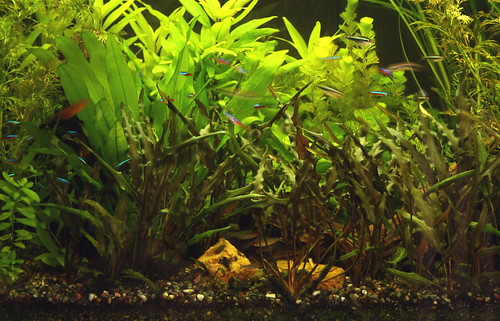
Cryptocorynes are widely spread genus of plants. They can be found from Vietnam, Malaysia, Indonesia to India and New Guinea. The number of species that are known is increasing due to chromosomal research. Many plants that were thought to be varieties are actually different species.
Many of the crypts available come from Sri Lanka. These include C. wendtii, C. walkerii (C. lutea), C. undulada, and C. becketii. In the wild these are usually found in small streams growing in various types of soil, usually in acidic water. Some of the soil types they are found growing in are sand, clay and rotten leaf litter. These crypts are not only more available but also are perhaps some of the easier types to keep in aquaria.
Cryptocorynes are beautiful plants and are popular in the aquarium hobby. Some consider them difficult to keep because of their habit of "melting" when environmental factors are changed. Often when the pant is brought home its leaves will melt and it may take a month or two before the plant recovers from the transplant shock and begins to grow again. Other things, like changing light bulbs and large water changes can cause the crypts to melt.
To successfully keep crypts, the soil or substrate in the aquarium must contain lots of nutrients. Using a substrate with a clay base will often provide most of the nutrients needed. One can also put laterite underneath the gravel bed. Crypts also benefit from the use of fertilizer tabs or sticks placed near the root system. Crypts, like most plants also need light to grow. Cryptocorynes are considered a low light plant. This means they can easily be kept under regular fluorescent lighting. They can also successfully be kept under high light conditions. They also benefit form CO2 or some other source of carbon (such as flourish excel).
To prevent the dreading "melting" that is the bane of crypt keepers, make environmental changes slowly. If you have multiple bulbs over your tank, and they need changing, change one at a time, spacing them a few weeks to a month apart. Avoid large water changes, do more frequent smaller ones instead. Also, avoid doing heavy doses of fertilizers. Smaller dosing more often will work much better with the crypts. If your soil has enough nutrients crypts do not usually need much in they of liquid fertilizers.
Over all it does not take much to keep the more commonly available crypts happy. A nutrient rich soil and slow environmental changes are perhaps the two most important things to remember.
Picture credit: Wandering Angel
Monday, July 23, 2007
Cryptocorynes
Posted by
Melgrj7
at
12:32 AM
![]()
Labels: cryptocorynes
Subscribe to:
Post Comments (Atom)



No comments:
Post a Comment